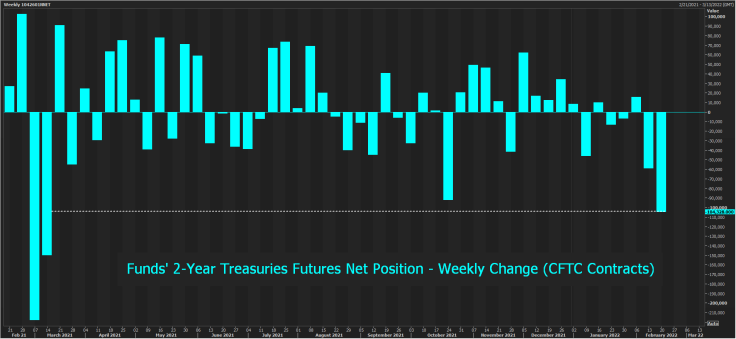Column-Funds Win Again With U.S. Curve Flatteners: McGeever
Another week, another big win for hedge funds betting on a flatter U.S. yield curve.
Futures market data for the week through Feb. 15 show that funds' extending their bets on a narrower gap between two- and 10-year yields coincided with one of the most dramatic 24-hour periods at the short end of the curve in over a decade.
The pace of flattening this year, however, has been so rapid that a period of consolidation may now be in store: in recent days the 2s/10s part of the curve has begun to steepen, and frenzied interest rate expectations have cooled. Slightly.
The latest Commodity Futures Trading Commission report shows that funds increased their net short position in two-year Treasuries by more than 104,000 contracts to 115,758 contracts in the week through Feb. 15.
That is the largest overall net short since October, and the weekly change marked the most bearish shift since last March. It was wholly driven by liquidation of long positions rather than funds opening fresh short positions.
(Graphic: CFTC Funds' 2-Yr Treasuries Net Position - Weekly Change,

)
A short position is essentially a bet that an asset's price will fall, and a long position is a bet it will rise. In bonds, yields rise when prices fall, and move lower when prices rise.
The week in question covers Thursday Feb. 10, when figures showed U.S. inflation at a 40-year high of 7.5%, St. Louis Fed President James Bullard said he had turned "dramatically" more hawkish, and the two-year yield soared 24 basis points.
That was the biggest one-day rise since 2009 and contributed to a 13-basis point narrowing of the spread between two- and 10-year yields, the fourth biggest compression in a decade.
The 2s/10s curve flattened to 35 basis points on Feb. 14, the lowest since mid-2020. This is an increasingly loud warning that the Fed may tighten policy too aggressively and that the economy could soon stall or even tip into recession.
Other parts of the yield curve have flattened further and some parts of the rates futures curve have inverted. This is due to the ratcheting up of expectations that the Fed will raise rates aggressively to cool inflation.
Economists at JP Morgan on Friday were the latest to revise up their Fed outlook, to seven 25-basis point hikes this year, while strategists at Credit Suisse raised their 10-year U.S. yield forecast by 50 bps to 2.70%.
"We expect the curve to continue to flatten, but believe the extent to which flattening is already priced leaves little appeal to adding further exposure," Credit Suisse's Jonathan Cohn said.
Fatigue might be setting in though. Last week was the first in eight that the two-year yield declined week on week, even though it was only by a couple of basis points. Perhaps markets are realizing that Bullard, the Fed's most vocal hawk, doesn't speak for the whole rate-setting committee.
Money markets are no longer fully pricing in at least 150 basis points of tightening from the Federal Reserve this year, and the two-year yield has come off almost 20 basis points from its Feb. 10 high of 1.64%.
The CFTC report for the week through Feb. 15 also showed that funds cut their net short 10-year Treasuries futures holdings by 27,847 contracts to 174,063, the smallest since October.
The most eye-catching nugget was that this marked the third week in a row that funds added to their long positions, something they have not done since last May.
This suggests that the 10-year yield's recent climb above 2% for the first time since 2019 was attractive to investors who, with Russia and Ukraine on the brink of war, had extra incentive to buy the safest, most liquid asset in the world.
There may be life in the old bonds yet.
(Graphic: CFTC Funds' 10-Year Treasuries Longs - Weekly Change,

)
(The opinions expressed here are those of the author, a columnist for Reuters.)
(By Jamie McGeever; Editing by Lisa Shumaker)
© Copyright Thomson Reuters 2024. All rights reserved.







